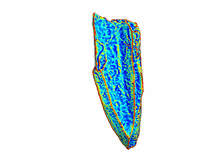The Anthropological and Mathematical Analysis of Archaeological and Zooarchaeological Evidence (AMAAZE) is an international consortium of anthropologists, mathematicians, and computer scientists who are working together to advance analytical methods and to use advanced mathematical methods to address important questions within archaeology and zooarchaeology.
Whether studying fossils, lithics, pottery, or other remnants of the past, archaeological analysis is grounded in identifying patterns and frequencies, which is inherently mathematical. Early research was founded on the observation and qualitative description of these patterns. Over the last several decades, the discipline has increasingly sought quantitative data analytical methods. Powerful tools such as 3d modeling, geometric morphometrics, and machine learning allows us to quickly capture and process massive amounts of information that cannot practically be gathered from physical measurements. Together, anthropologists, mathematicians, and computer scientists leverage their expertise to truly optimize these tools, the implications of which are expected to impact the current understanding of early human prehistory, culture, and origins.
Current projects include the Geometric Analysis for Classification and Reassembly of Broken Bones which uses mathematical techniques based on invariant signatures and moving frames to reassemble broken bones and to extract data that can be processed using machine learning for the purpose of classifying bone fragments according to the agents of breakage. Another project, the Digitization of Manual Methods in Lithic and Zooarchaeological Analysis, is developing semi-automated, digital methods for extracting measurements that are currently taken manually using implements such as a goniometer. Not only does this research have the potential to revolutionize archaeological and zooarchaeological inquiry, these methods can benefit the fields of paleontology, forensics, and medicine.
This website serves as the face of our consortium and a central hub where other researchers and the general public can find materials produced from these projects, including formal conference proceedings, journal articles, 3D models, slides from talks, and participant data. Multiple publications are expected and data, such as computer code and extracted shape data, will be made available after the publication of articles presenting these data. All data and 3D models will be made available, as agreed to by collaborating partners. Metadata and source information will be included for data that cannot be shared publicly.
Members of this consortium create an energetic, positive environment that fosters innovative, collaborative research. Our interdisciplinary approach leverages expertise from various facets of mathematics and anthropology. Working together through our combined expertise, we optimize resources that we otherwise would not have access to and increase our impact within our respective disciplines. If you are interested in joining this consortium or collaborating with us, please contact us at [email protected].

